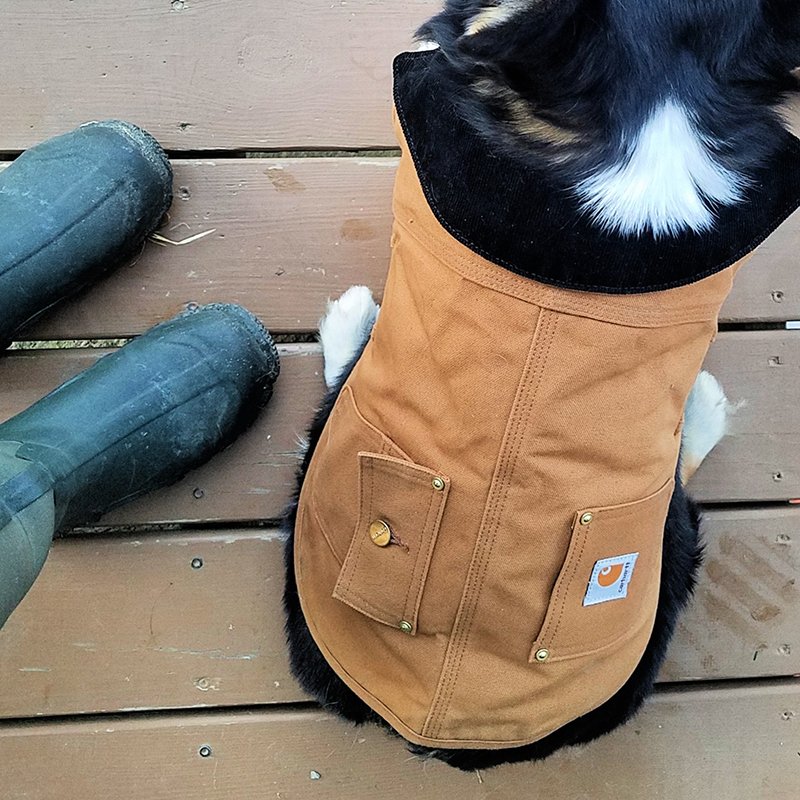

It’s pouring, snowing or bitterly cold, but still, it’s time to take your dog for a walk. You’d like to put a coat on him, but when you try, he simply stands there, looking miserable and refusing to budge.
You’re not alone! But don’t worry: You actually can train your dog to like (okay, tolerate!) wearing a coat by changing how he feels about it. In other words, instead of the coat being scary or something your dog flat-out dislikes, he can learn to at least accept it. The following steps outline how to accomplish this.
• Arm yourself with some delicious, high-value treats. (Note: When training a new behavior, especially when you’re trying to change your dog’s emotional response to something, it’s best to use treats he absolutely loves but doesn’t typically get.)
• Choose a time when your dog is relatively relaxed, such as after a long walk or playing ball.
GET THE BARK NEWSLETTER IN YOUR INBOX!
Sign up and get the answers to your questions.
• Put the coat on the floor several feet away from him and observe his reaction. If he runs away or shows any signs of stress—yawning, flicking his tongue, closing his mouth tightly, turning his body away—you’ll need to put even more distance between your dog and the coat.
• Once your dog shows no reaction to the coat, praise him and give him a treat.
• Still keeping a good distance between your dog and the coat, put the coat down and wait for your dog to look at it. He doesn’t have to sniff it or even walk near it; a quick glance will do. Praise and treat! Do this several more times.
• Continue with this exercise as you move the coat closer and closer to your dog. Remember, you’re still not actually touching him with it. You’re just decreasing the distance between the two of them, and giving him a treat when he looks at it.
• Once your dog understands that simply looking at the coat results in a treat (we like to go for eight out of 10 times), try gently touching the coat to one of his front legs for a second. Don’t put it on him; just touch him briefly with it. We suggest front legs because you want to make sure your dog can see what you’re doing. No one likes surprises, especially when it’s something they may think is scary.
• If he stands there and does nothing, give him a treat and lots of praise! If he seems only mildly stressed, take the coat away and then, holding a treat near his nose, try touching him again very gently with it. If he seems very stressed, go back to the previous step, where he gets rewarded just for looking at the coat.
• Once you can touch your dog with the coat, try petting him with the coat in your hand. If he doesn’t move or show any sign of stress, treat him.
You get the idea. The key is baby steps. Take your time and don’t rush moving on to the next step. Soon, your dog will connect the dots and realize everything to do with the coat results in treats!
When you’re finally ready to put the coat on him, just lay it over his back for a second, then remove it and treat him. Only when he’s comfortable at this stage (again, eight out of 10 times) should you try putting it on and fastening it. Just like any other behavioral training, this is a process. Be patient and go slowly.
You may also be wondering: “Does my dog really need to wear a coat?” Well, it depends.
If your dog naturally has a long, thick coat—think Husky or Pomeranian—the answer is probably not. But if your dog is slick-coated, very young, elderly or suffering from a medical condition such as arthritis, a coat can help keep him comfortable when temperatures drop. Also, if your dog is small, you may want to consider a coat, as it’s harder for little guys to retain body heat.
Finally, think about how long you’re going to be outside. Your dog may be fine going coatless on a brief, 10-minute walk to do his business. But if you’re planning to take a hike on a cold winter’s day, he’ll probably appreciate some help staying warm.